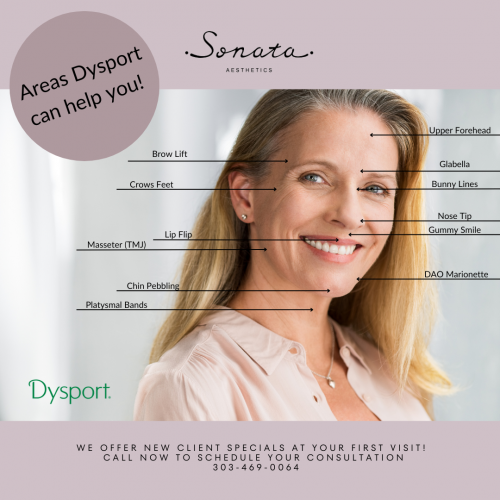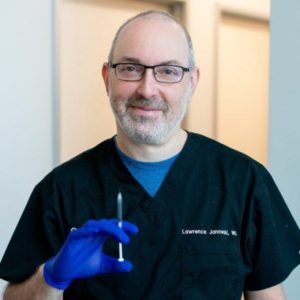Dysport® Injections
Dysport® has many different uses,
find out if one is right for you!
Serving Denver, Broomfield, Westminster, Boulder, Arvada, and surrounding areas
Schedule a free consultation with one of the top injectors in the country!
Quick Navigation
Dysport® vs. Botox® **
Most of our past clients have been very satisfied with Botox®. However, if you’ve wanted to try Dysport and compare for yourself or you feel your results with Botox® are not ideal, now is the time.

How do neuromodulators (Dysport® & Botox®) work?
Botulinum toxin is one of the most powerful neurotoxins known to man and has proven to be an incredibly successful and valuable therapeutic protein. It can be injected into humans in small doses, and works by preventing muscles from receiving signals from nerve cells - either paralyzing or weakening them. Botox® and Dysport both help to prevent the release of acetylcholine, a neurotransmitter that attaches to muscle cells and causes them to contract. Because they prevent this from happening, the muscles become less stiff and essentially "soften" in the treated area(s). When the pull of the muscle relaxes, the overlying skin generally flattens out - thus reducing wrinkles and/or creases.
What can Dysport® be used for?
There are recent amazing studies showing that Neuromodulators can actually make you happy!
How is the procedure performed?
Dysport is injected directly into the neuromuscular tissue in the desired area, using a very small needle. Dr. Janowski has perfected a technique he calls the “snap technique” in order to make the procedure virtually painless. It typically takes between 24-72 hours to take effect. The entire procedure usually only takes a few minutes, and you can go back to all regular daily activities immediately afterwards.
We recommend that pregnant or lactating women, or people who have had a previous allergic reaction, not use Botox® or Dysport for their medical aesthetic needs.
Are neuromodulators what you really want or need?
Botox® and Dysport have long been described as the "gateway" into medical aesthetics. Many of our new patients request consultations for Dysport injections, but actually need something else based on area of the face/body and expectations. While there are a myriad of uses for both, sometimes a different treatment plan makes more sense. This is a large part of why we offer a free consultation with the Dr. - we don't want to treat you with Dysport if there is a better alternative to give you the absolute best results!
- Post-treatment instructions for your Dysport treatment: Aftercare Instructions
- Be an informed neuromodulator consumer: Read more in our Dysport Buyer’s Guide
Botox®/Dysport® vs. Fillers – what’s the difference?
We get questions everyday about the differences between Botox®, Dysport, and Dermal Fillers. These are excellent questions, as Botox®, Dysport, and Dermal Fillers work in different ways, and are used together for the best effect.
Botox® and Dysport are neurotoxins that relaxes the muscles that cause the expressions leading to wrinkles. They are mostly used in the upper face to relax expression lines and prevent new ones from forming. Dysport typically lasts for about 3 months, and have the best effects when repeated regularly.
Dermal Fillers do exactly what their name implies – they fill in places on the face that have lost volume. All faces lose volume as we age, and you may notice hollower cheeks, sunken eyes, and thin lips. These are all natural occurrences because as we age, the collagen in our skin that makes our faces appear youthful and full deteriorates. Fillers replace what Mother Nature is losing. Dermal fillers (like Restylane and Radiesse) use naturally occurring substances in the body to add volume to places that have lost it. Fillers can fill in wrinkles, add volume to cheeks, and plump up lips.
Fillers typically last between 6 months to a year – although there are new fillers that can last even longer now like Sculptra, and fat transfer.
People often ask if receiving filler, botox, or dysport injections hurt. While you are receiving an injection in your face, the good news is that each contain lidocaine – a pain killer, which means that you are being numbed as you are receiving the fillers. Most people experience no pain and will actually feel somewhat numb in the injection area after the procedure.
Injecting properly is an art, and you definitely want to choose an experienced provider. Each person’s face is unique and knowing where to add in filler, botox, or dysport, and how much requires years of careful practice and experience. It should look natural, and an experienced provider will know how to make you look like a natural, improved version of yourself.
Are neuromodulators safe?
Many of our new patients ask us if Dysport is safe – as it is, in fact, neurotoxins. In order to answer that question, we want to share a little bit about the history of Botox®. Botox® (onabotulinumtoxin A) was first used for medical purposes in 1989. Developed by Allergan, which was (and still is) a pharmaceutical company that develops treatments for eye issues, Botox® was originally approved for the treatment of muscle spasms. That is because what Botox® does is it relaxes the muscles into which it is injected. You may have seen advertisements touting the use of Botox® for Migraines, eye concerns, or even bladder-control issues, and it works in all these cases by relaxing muscles.
The botulinum toxin is actually FDA approved to treat a myriad of “conditions”, including: chronic migraines, excessive underarm sweating, overactive bladder, crossed eyes, and severe neck spasms. It’s also approved for cosmetic uses in both the upper and lower face.
Botox® and Dysport are very well-tested, well-researched and widely used drugs. Allergan reports patient satisfaction with Botox® at 98%, which is an incredibly high number. In 2013 alone, over 5 million American received Botox® treatments, and the number of users only continues to grow. Since 2002, when Botox® was approved for cosmetic purposes, no long term adverse side effects have been reported. The most common side effect usually seen is some pinpoint bruising at the injection site. About once a year, we also hear about someone having a mild headache post treatment from Dysport.
The best way to ensure you have a great Dysport treatment is to have your injections done by a skilled, highly experiences physician. An experienced physician will best understand your facial anatomy and the muscles in your face, and will be able to give you the most exact does and precise placement. A physician will also be able to treat you in the safest and most sterile environment and will be able to handle any complication that arises.
Areas in the Upper Face Treated with Dysport®
Dysport® targets the main underlying cause of frown lines on our forehead and between our eyes as well as crow’s feet. Dysport® works under the skin’s surface and addresses the underlying muscle activity that is causing the wrinkling between and around our eyes as well as on the forehead. Three main muscle areas are injected with Botox® helping visibly smoothing crow’s feet, frown lines and the lines between our brows.
Glabellar Region
This is the technical term for those awful “11’s” that can appear between our eyes. For many of us, this is the most noticeable area Dysport® can fix. This is also the area that can start to get noticeably wrinkly as early as our 20s and early-30s. When we frown and concentrate, the muscles between the brows contract, making the skin furrow and fold. Over time, this causes long lasting wrinkles, making us look old and even angry looking.
In our Broomfield, Colorado office, the doctor will inject five tiny areas, a single injection into your procerus muscle (right between the eyes) and four into the corrugator muscles (right above the top of eyebrow, on the side of the arch closest to your nose).
Forehead
Reducing the horizontal lines across our forehead can have a dramatic effect on how we look and feel. Dysport® treats the frontalis muscle and the number of injections will depend on the amount of wrinkling to be addressed.
Crow’s Feet
Those wrinkles on the outer sides of our eyes resemble the foot of a bird or crow tend to become long lasting as we age. When we are young, these wrinkles only appear when we are smiling and laughing. Then as we age, they start to become more and more noticeable even when we are at rest, and not smiling or laughing. The doctor injects three areas of the orbicularis oculi, the muscles on the outer side of the eye temporarily reducing the activity in those muscles. Often these lines completely disappear.
Dysport® treatments usually take just a few minutes. Most patients report the procedure feeling like a series of tiny pinches. Dr. Janowski uses his specialized “snap technique” in our Broomfield, Colorado office, which makes the injections as painless as possible. There is no downtime or recovery. You can go about your normal routine as soon as you leave the doctor’s office, including putting on sunscreen and makeup.
Results are visible in about 5 days post treatment and usually last for up to three to four months.*
Avoiding Bruising
Most patients don’t tend to bruise as the needle is extremely small. That said, if you are prone to bruising, here are some guidelines. If you are concerned about bruising, please let us know and we can take extra precautions when you visit.
- Avoid blood thinners for a week before your treatment (if you can) including: aspirin, ibuprofen, fish oil supplements and omega 3s
- Topical and/or ingestible Arnica may help reduce bruising and swelling
- On the day of your treatment, avoid strenuous exercise
Dysport® FAQ's
Watch additional Dysport Videos
Why choose Sonata Aesthetics for your Dysport®?
Dr. Janowski is one of the most experienced injectors in the state, and has seen thousands of patients since 2004. He is currently ranked #1 in Colorado (and top 20 in the United States) for his expertise in injecting dermal fillers, and is an official trainer to other Dr’s on use and technique.
He has even developed his own technique, called the “snap technique” in order to minimize pain and bruising, and to ensure longer lasting and more natural results. This is his own specialized way of holding the needle so that he is able to insert into the skin as quickly as possible. Once the needle is under the skin, it generally doesn’t hurt – and he can then carefully place the product in the most ideal location.
Dr. Janowski has received one-on-one master training with world-renowned physicians from around the world, such as Dr. DeMaio of Brazil, Dr. Yoelin of California, Dr. Rajaniof Portland, and Dr. Vieggarof Switzerland.
Schedule your Free consultation today!
We would love to meet with you to answer any other questions you might have, or to schedule a free 1 on 1 consultation with one of the best injectors in the state (and country).
We take special care and time with each and every patient in order to determine which filler is best for you and which areas can best benefit from filler treatment.
*Results may vary from patient to patient

